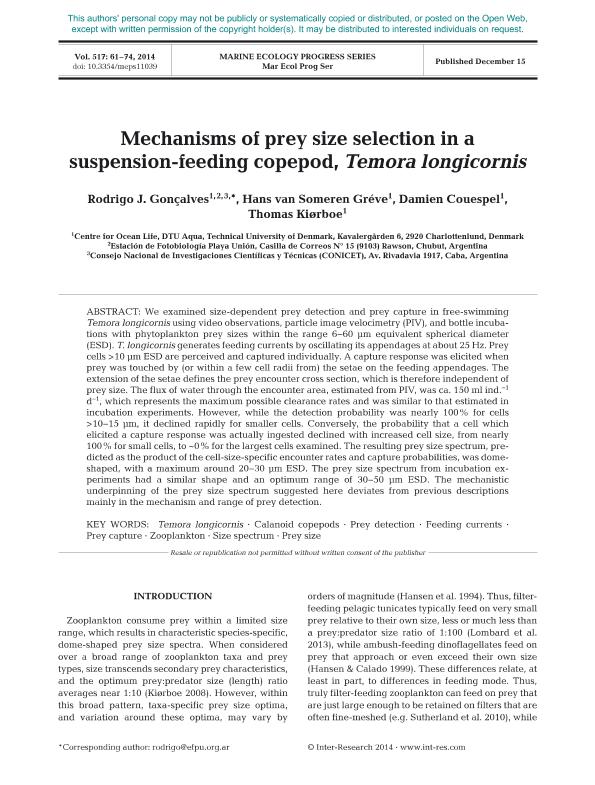Mostrar el registro sencillo del ítem
dc.contributor.author
Gonçalves, Rodrigo Javier

dc.contributor.author
van Someren Gréve, Hans
dc.contributor.author
Couespel, Damien
dc.contributor.author
Kiørboe, Thomas
dc.date.available
2017-06-29T20:10:18Z
dc.date.issued
2014-12-15
dc.identifier.citation
Gonçalves, Rodrigo Javier; van Someren Gréve, Hans; Couespel, Damien; Kiørboe, Thomas; Mechanisms of prey size selecon in a suspension feeding copepod, Temora longicornis; Inter-research; Marine Ecology Progress Series; 517; 15-12-2014; 61-74
dc.identifier.issn
0171-8630
dc.identifier.uri
http://hdl.handle.net/11336/19203
dc.description.abstract
We examined size-dependent prey detection and prey capture in free-swimming Temora longicornis using video observations, particle image velocimetry (PIV), and bottle incubations with phytoplankton prey sizes within the range 6-60 µm equivalent spherical diameter (ESD). T. longicornis generates feeding currents by oscillating its appendages at about 25 Hz. Prey cells >10 µm ESD are perceived and captured individually. A capture response was elicited when prey was touched by (or within a few cell radii from) the setae on the feeding appendages. The extension of the setae defines the prey encounter cross section, which is therefore independent of prey size. The flux of water through the encounter area, estimated from PIV, was ca. 150 ml ind.-1 d-1, which represents the maximum possible clearance rates and was similar to that estimated in incubation experiments. However, while the detection probability was nearly 100% for cells >10-15 µm, it declined rapidly for smaller cells. Conversely, the probability that a cell which elicited a capture response was actually ingested declined with increased cell size, from nearly 100% for small cells, to ~0% for the largest cells examined. The resulting prey size spectrum, predicted as the product of the cell-size-specific encounter rates and capture probabilities, was dome-shaped, with a maximum around 20-30 µm ESD. The prey size spectrum from incubation experiments had a similar shape and an optimum range of 30-50 µm ESD. The mechanistic underpinning of the prey size spectrum suggested here deviates from previous descriptions mainly in the mechanism and range of prey detection.
dc.format
application/pdf
dc.language.iso
eng
dc.publisher
Inter-research

dc.rights
info:eu-repo/semantics/embargoedAccess
dc.rights.uri
https://creativecommons.org/licenses/by-nc-sa/2.5/ar/
dc.rights.uri
https://creativecommons.org/licenses/by-nc-sa/2.5/ar/
dc.rights.uri
https://creativecommons.org/licenses/by-nc-sa/2.5/ar/
dc.subject
Calanoid Copepods
dc.subject
Feeding Currents
dc.subject
Prey Capture
dc.subject
Prey Detection
dc.subject
Prey Size
dc.subject
Size Spectrum
dc.subject
Temora Longicornis
dc.subject
Zooplankton
dc.subject.classification
Biología Marina, Limnología

dc.subject.classification
Ciencias Biológicas

dc.subject.classification
CIENCIAS NATURALES Y EXACTAS

dc.title
Mechanisms of prey size selecon in a suspension feeding copepod, Temora longicornis
dc.type
info:eu-repo/semantics/article
dc.type
info:ar-repo/semantics/artículo
dc.type
info:eu-repo/semantics/publishedVersion
dc.date.updated
2016-11-23T19:39:55Z
dc.identifier.eissn
1616-1599
dc.journal.volume
517
dc.journal.pagination
61-74
dc.journal.pais
Alemania

dc.description.fil
Fil: Gonçalves, Rodrigo Javier. Technical University of Denmark; Dinamarca. Fundación Playa Unión. Estación de Fotobiología Playa Unión; Argentina. Consejo Nacional de Investigaciones Científicas y Técnicas; Argentina
dc.description.fil
Fil: van Someren Gréve, Hans. Technical University of Denmark; Dinamarca
dc.description.fil
Fil: Couespel, Damien. Technical University of Denmark; Dinamarca
dc.description.fil
Fil: Kiørboe, Thomas. Technical University of Denmark; Dinamarca
dc.journal.title
Marine Ecology Progress Series

dc.rights.embargoDate
2019-12-16
dc.relation.alternativeid
info:eu-repo/semantics/altIdentifier/url/http://www.int-res.com/abstracts/meps/v517/p61-74/
dc.relation.alternativeid
info:eu-repo/semantics/altIdentifier/doi/http://dx.doi.org/10.3354/meps11039
Archivos asociados
